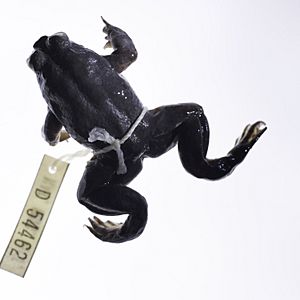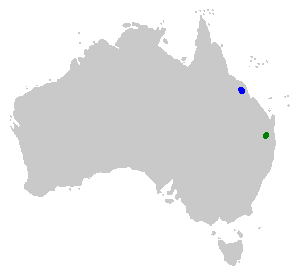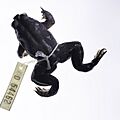Gastric-brooding frog facts for kids
Quick facts for kids Gastric-brooding frogs |
|
|---|---|
 |
|
| Southern gastric-brooding frog (Rheobatrachus silus) | |
| Conservation status | |
| Scientific classification |
|
| Kingdom: | Animalia |
| Phylum: | Chordata |
| Class: | Amphibia |
| Order: | Anura |
| Family: | Myobatrachidae |
| Subfamily: | †Rheobatrachinae Heyer & Liem, 1976 |
| Genus: | †Rheobatrachus Liem, 1973 |
 |
|
| The former distributions of Rheobatrachus silus (green) and Rheobatrachus vitellinus (blue) | |
The gastric-brooding frogs (also called platypus frogs) were a special kind of frog that lived on the ground in Queensland, Australia. There were only two types, and sadly, both became extinct in the mid-1980s. What made them super unique was how the mother frog would keep her young inside her own stomach until they were ready to hop out!
These frogs lived in a small area, less than 2,000 square kilometres (770 sq mi) in total. They preferred areas near creeks in rainforests, usually high up in the mountains. Scientists are not completely sure why they disappeared. It might have been due to losing their homes, pollution, or even diseases.
In 2013, scientists from the University of Newcastle and University of New South Wales started a project called the "Lazarus Project." They are trying to bring these frogs back to life using cloning methods. They have already made embryos, and they hope to eventually create a living frog!
Contents
Types of Gastric-Brooding Frogs
There were two main types of gastric-brooding frogs: the Southern gastric-brooding frog and the Northern gastric-brooding frog. Both were quite different from other Australian frogs. They had big, bulging eyes, short snouts, and webbed feet. Their bodies were also slimy. They spent most of their time in water, which was unusual for Australian frogs.
Southern Gastric-Brooding Frog (R. silus)
The Southern gastric-brooding frog (Rheobatrachus silus) was found in 1972. It lived in the Blackall and Conondale Ranges in southeast Queensland, north of Brisbane. Its home was limited to less than 1,400 square kilometres (540 sq mi) of rainforests and wet forests near rivers.
The last time this frog was seen in the wild was in 1981. The last one kept in captivity died in 1983. Because of this, it is now believed to be extinct.
What they looked like
The Southern gastric-brooding frog was a medium-sized frog. It had a dull grey or slate color with darker and lighter patches on its back. Its belly was white or cream, sometimes with yellow spots. Its arms and legs had dark brown stripes.
Its eyes were large and stuck out, placed close together. It had a short, blunt nose. Its skin was moist and covered in mucus. The fingers were long and slender, but the toes were fully webbed. Female frogs were usually bigger than males. Males were about 33 to 41 millimetres (1.3 to 1.6 in) long, and females were 44 to 54 millimetres (1.7 to 2.1 in) long.
Where they lived and what they did
These frogs lived in rainforests and wet forests, always close to water. They preferred permanent streams and rock pools. They were often found hiding among leaves, under stones, or in rock cracks. During colder months, they probably went into a deep sleep, like hibernation.
Adult males liked deeper pools, while younger frogs and females preferred shallower pools. They only came out into the open when it was raining lightly.
The call of the Southern gastric-brooding frog sounded like "eeeehm...eeeehm." It lasted about half a second and was repeated every 6–7 seconds. They ate insects they found on land and in the water.
These frogs did not move around much. Most stayed within a few meters of their home. They only moved further if there was a flood or strong water flow.
Northern Gastric-Brooding Frog (R. vitellinus)
The Northern gastric-brooding frog (Rheobatrachus vitellinus) was discovered in 1984. It lived in the rainforests of the Clarke Range in Eungella National Park in central eastern Queensland. Its home was even smaller, less than 500 square kilometres (190 sq mi).
Sadly, just one year after it was discovered, it was never seen again. Despite many searches, this species is also considered extinct.
What they looked like
The Northern gastric-brooding frog was much larger than the southern type. Males were about 50–53 millimetres (2.0–2.1 in) long, and females were 66–79 millimetres (2.6–3.1 in) long. They were usually pale brown and had bumpy, slimy skin. They had bright yellow spots on their belly and the underside of their arms and legs. Their body shape was very similar to the southern species.
Where they lived and what they did
These frogs lived only in untouched rainforests. Like their southern relatives, they were mostly aquatic. They were found in shallow, fast-flowing creeks and streams. They hid under or between rocks in the water. The water in these streams was cool and clear.
Male Northern gastric-brooding frogs called from the water's edge during summer. Their call was loud and made of several short notes. It was similar to the southern frog's call but deeper and repeated less often. They ate caddisfly larvae, beetles, and even other small frogs.
Reproduction and Life Cycle
What made these frogs truly amazing was how they raised their young. After the male fertilized the eggs, the female would pick up the eggs or tiny embryos with her mouth and swallow them! It's not known if the eggs were laid on land or in water, as no one ever saw it happen before they disappeared.
The eggs were quite large and had a lot of yolk, which is like food for the developing babies. A female frog usually had about 40 ripe eggs. However, only about 21–26 young frogs were ever found in a mother's stomach. This might mean that some eggs were not swallowed, or the first ones swallowed were digested.
When the female swallowed the eggs, her stomach was normal. But around each egg was a special substance called prostaglandin E2 (PGE2). This substance could turn off the production of hydrochloric acid in the stomach. This meant the mother's stomach became a safe place for the babies to grow.
Once the eggs hatched, the tadpoles also produced PGE2 in their mucus. This mucus kept the stomach from working normally, so the mother wouldn't digest her young. During this time, the mother frog would not eat anything.
The tadpoles developed inside the mother's stomach for at least six weeks. As they grew, the mother's stomach got bigger and bigger, filling most of her body. Her lungs would deflate, and she would breathe more through her skin. Even with a huge stomach, the mother frog stayed active.
When the young frogs were ready, the mother would "give birth" by spitting them out. This process could take up to a week. However, if she was disturbed, she might throw up all the young frogs at once! The baby frogs were fully developed when they came out and looked like tiny versions of the adults.
Why They Disappeared
Scientists believe the gastric-brooding frogs became extinct because of a disease caused by a fungus. This fungus, called chytrid fungus, was likely brought into their homes by humans.
For the Southern gastric-brooding frog, logging activities were happening in their areas. While the frogs were still found in logged areas, the long-term effects were not fully studied. Their homes are now also threatened by wild pigs, invasive plants, and water pollution. Despite many searches, this frog has not been seen since 1981.
For the Northern gastric-brooding frog, its home in Eungella National Park was threatened by bushfires and invasive plants. The chytrid fungus has also been found in creeks in the park. It is now widely believed that this disease was the main reason both types of gastric-brooding frogs disappeared.
In 2010, a group of scientists searched for many frog species thought to be extinct, including the gastric-brooding frog, but they were not found.
Conservation Status
Both types of gastric-brooding frogs are officially listed as Extinct by the IUCN Red List and by Australia's Environment Protection and Biodiversity Conservation Act 1999. However, they are still listed as Endangered under Queensland's Nature Conservation Act 1992.
Bringing Them Back to Life
Scientists are working hard to bring the gastric-brooding frog species back to life. They are using a method called somatic-cell nuclear transfer (SCNT), which is a way of cloning.
In March 2013, Australian scientists successfully created a living embryo from preserved genetic material of the frog. These scientists, led by Professor Michael Mahony (who first discovered the Northern gastric-brooding frog) and Professor Mike Archer, hope to continue their work. Their goal is to produce an embryo that can grow into a tadpole and eventually a living frog. Professor Archer said, "We do expect to get this guy hopping again."
The scientists have also managed to successfully freeze and thaw amphibian embryonic cells. This is important because it shows that freezing cells can create a "genome bank" to help save threatened amphibians and other animals.
Images for kids
- Gastric-brooding frog at the Encyclopedia of Life
See also
 In Spanish: Rheobatrachus para niños
In Spanish: Rheobatrachus para niños




